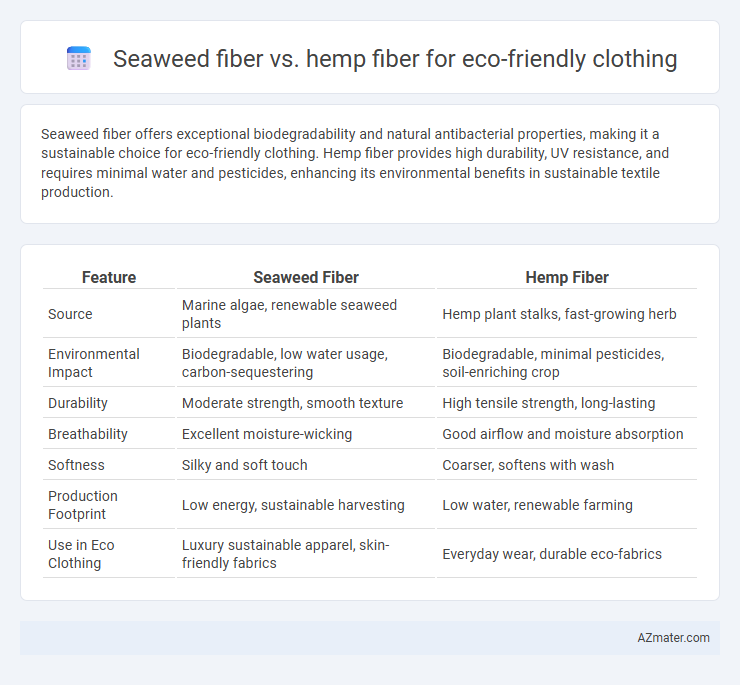Seaweed fiber offers exceptional biodegradability and natural antibacterial properties, making it a sustainable choice for eco-friendly clothing. Hemp fiber provides high durability, UV resistance, and requires minimal water and pesticides, enhancing its environmental benefits in sustainable textile production.
Table of Comparison
| Feature | Seaweed Fiber | Hemp Fiber |
|---|---|---|
| Source | Marine algae, renewable seaweed plants | Hemp plant stalks, fast-growing herb |
| Environmental Impact | Biodegradable, low water usage, carbon-sequestering | Biodegradable, minimal pesticides, soil-enriching crop |
| Durability | Moderate strength, smooth texture | High tensile strength, long-lasting |
| Breathability | Excellent moisture-wicking | Good airflow and moisture absorption |
| Softness | Silky and soft touch | Coarser, softens with wash |
| Production Footprint | Low energy, sustainable harvesting | Low water, renewable farming |
| Use in Eco Clothing | Luxury sustainable apparel, skin-friendly fabrics | Everyday wear, durable eco-fabrics |
Introduction to Eco-Friendly Textile Fibers
Seaweed fiber and hemp fiber are emerging as sustainable alternatives in the eco-friendly textile industry, prized for their low environmental impact and biodegradability. Seaweed fiber, derived from algae species like kelp, offers natural antimicrobial properties and moisture-wicking benefits, making it ideal for performance clothing. Hemp fiber stands out due to its durability, rapid growth cycle requiring minimal water and pesticides, and ability to improve soil health, positioning it as a powerful resource for sustainable fashion.
What Are Seaweed Fibers?
Seaweed fibers, derived from cultivated seaweed species such as kelp, are achieved through a patented process that extracts bio-cellulose to produce a sustainable fabric with natural antibacterial properties and moisture-wicking abilities. Compared to hemp fiber, seaweed fiber is softer, lighter, and offers enhanced skin benefits due to the presence of natural minerals and antioxidants. This innovative material contributes to eco-friendly clothing by utilizing renewable marine biomass, requiring less land and freshwater than traditional terrestrial crops like hemp.
What Are Hemp Fibers?
Hemp fibers are derived from the stalks of the Cannabis sativa plant, known for their durability, breathability, and natural resistance to mold and UV rays, making them ideal for eco-friendly clothing. These fibers are biodegradable, require less water and pesticides compared to cotton, and promote sustainable agriculture, aligning with green fashion efforts. Unlike seaweed fibers that offer a silky texture and moisture-wicking properties, hemp fibers provide a coarser, stronger fabric used in both casual wear and industrial applications.
Sustainability Comparison: Seaweed vs. Hemp
Seaweed fiber offers rapid renewability with growth cycles of just weeks, significantly reducing resource consumption compared to traditional crops, while hemp fiber requires minimal water and no pesticides, promoting soil health through crop rotation. Both fibers contribute to eco-friendly clothing by being biodegradable and carbon-negative, yet seaweed's ability to absorb oceanic carbon and release oxygen provides a unique environmental benefit beyond hemp's land-based cultivation advantages. The sustainable sourcing of seaweed minimizes land use, whereas hemp's robust yield per hectare enhances agricultural efficiency, making their combined use a complementary strategy for advancing green textile innovation.
Environmental Impact of Seaweed and Hemp Cultivation
Seaweed fiber production benefits from rapid growth rates and minimal land use, reducing deforestation and soil degradation compared to traditional crops. Hemp cultivation requires low water input and naturally repels pests, decreasing the need for chemical pesticides and fertilizers, which helps preserve soil and water quality. Both fibers contribute to eco-friendly clothing by promoting sustainable agriculture practices with comparatively low carbon footprints and enhanced biodiversity.
Fiber Properties: Durability, Comfort, and Breathability
Seaweed fiber offers exceptional breathability and a soft texture, making it ideal for comfortable eco-friendly clothing, while hemp fiber is renowned for its superior durability and strength, providing long-lasting fabric resilience. Both fibers are naturally moisture-wicking and breathable, enhancing wearer comfort in various climates. Choosing between seaweed and hemp fibers depends on the desired balance between softness and robustness in sustainable apparel.
Processing and Manufacturing Differences
Seaweed fiber is produced through a complex process involving the extraction of cellulose from seaweed, often combined with biodegradable polymers to create soft, breathable fabric, while hemp fiber undergoes mechanical retting and decortication, followed by spinning into durable yarns. Seaweed fiber manufacturing emphasizes sustainability by utilizing renewable marine resources and minimal chemical treatments, whereas hemp processing requires land cultivation but yields strong, long-lasting fibers with natural antibacterial properties. Both fibers offer eco-friendly alternatives, but seaweed fiber tends to be more innovative and less resource-intensive in its production methods compared to the traditional hemp fiber processing.
Applications in Sustainable Fashion
Seaweed fiber offers biodegradability and natural antibacterial properties, making it ideal for eco-friendly activewear and casual clothing designed for sustainability. Hemp fiber is highly durable, moisture-wicking, and UV-resistant, commonly used in producing long-lasting apparel such as workwear and outdoor gear with low environmental impact. Both fibers contribute to reducing plastic use and chemical dyes in sustainable fashion by supporting zero-waste and organic material initiatives.
Consumer Appeal and Market Trends
Seaweed fiber, known for its natural antibacterial properties and silky texture, is rapidly gaining consumer appeal in the eco-friendly clothing market due to its sustainability and skin-friendly benefits. Hemp fiber stands out for its durability and moisture-wicking abilities, attracting eco-conscious consumers seeking long-lasting, breathable fabrics. Market trends show increasing demand for both fibers as brands emphasize transparency, biodegradability, and reduced environmental impact in textile production.
Conclusion: Choosing the Best Eco-Friendly Fiber
Seaweed fiber offers exceptional softness, antibacterial properties, and biodegradability, making it ideal for sustainable, skin-friendly clothing. Hemp fiber boasts superior durability, UV protection, and minimal water use during cultivation, ensuring long-lasting, eco-conscious garments. Selecting between seaweed and hemp fibers depends on prioritizing either comfort and biodegradability or strength and resource efficiency in eco-friendly fashion.

Infographic: Seaweed fiber vs Hemp fiber for Eco-friendly clothing
 azmater.com
azmater.com